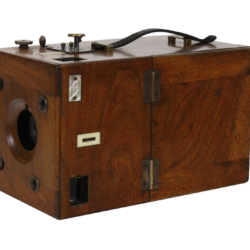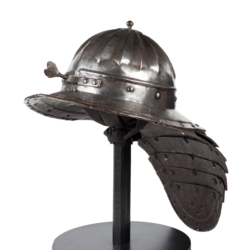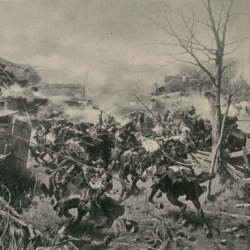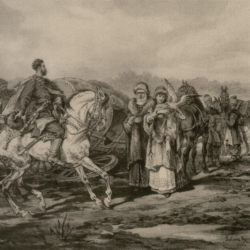
Fun
Entertainment was the first dimension in which these contradictory tendencies were negotiated.
After the screening of one of the first films based on Sienkiewicz’s work – the Italian 1913 adaptation of Quo vadis? directed by Enric Guazzoni, Jan Skarbek-Malczewski wrote:
The premiere was grandiose. Authorities and press representatives were invited, while the social elite of Warsaw filled the room. So many were wishing to attend the next screenings, that entire crowds would leave the box office empty-handed […] The most stunning scene depicted Ligia tied to bull’s horns – even though the bull was not a bull, but rather a big calf. In the next part of this tragic scene, the actress playing Ligia was substituted by a dummy. There was a gladiator fight, Neron watching from the stands, and powerful emotions on part of the film audience, to the emotions of which the presence of the orchestra also contributed.[1]
The author of this commentary had first-hand experience with filming, as he was the camera operator of the early Polish films, such as Pola Negri’s debut Slave of Sin (1914), or Słodycz Grzechu [The Sweetness of Sin] (1914) and Meir Ezofowicz (1911) starring Maria Dulęba. Skarbek-Malczewski knew tricks which strengthened the illusion of tangibility and realness of the filmed scenes. The goal was not authenticity, but the credibility induced by emotional power.
A good example of this technique is a minor episode of Everything for Sale (1969) directed by Andrzej Wajda. The director’s alter ego (Andrzej Łapicki) visits the filmset of Colonel Wolodyjowski in order to have a conversation with an extra (Wiesław Dymny) who knows Zbyszek Cybulski. The protagonist arrives in a helicopter, and observes troops in the armor of the Polish Hussars preparing for a battle scene. The extra, dressed in a “civilian” jacket with wings attached, is responsible for running round the camera, thus making the image of the battle more “packed” and dense. Wajda’s film was supposed to be critical (and autocritical) of historical films, showing that the past is always created, while the materials used for such creations are not always of the best quality. Nevertheless, Wajda still revealed the power of such films, which may abound in evocative representations and incite powerful sensations on the viewers’ part[2].
Sienkiewicz’s Trilogy, The Knights of the Cross, or In Desert and Wilderness were often discussed as works perfect for cinema and almost ready for screening, while their author was called “a great screenwriter”[3]. The greatest strengths of popular culture – violence and sex, incorporated in a narrative about a fight for love and values – surface here under the guise of a cloak and dagger film. Kissing scenes were for girls, while duels for boys: Kiss Kiss, Bang Bang, as film critic Pauline Kael wrote[4]. Culture critics and film critics sensed the great emotional potential of a cinematic spectacle – in particular, in connection with television, a new and powerful medium born in the middle of the 20th century. The viewers were raising this topic, too. One of the participants of a debate “Is Sienkiewicz worth screening”, which began in 1966 after the success of the movie The Knights of the Teutonic Order, argued: “The entire Trilogy or its parts should be adapted into a film about love, adventure, shooting and dynamism – with the horse, the girl, with the folklore of 17th century Poland in the background”[5]. Sienkiewicz was worth adapting, but mostly as the writer of moving adventure novels:
The film is thrilling and moving, and not only for younger audiences. Simple emotions have been described – akin to those incited by Love Story. There are records of people crying. In my opinion, an adult viewer has had more reasons “to cry from joy and sadness”, when in the last scene Staś holds unconscious Nel, laughing and weeping simultaneously. And the ending becomes even more powerful, when one realizes that it lacks a greeting exchanged between children and their parents because Jasiukiewicz, starring as Mr. Tarkowski, has passed away.
One could sigh, as in the ending of Sienkiewicz’s Hania: “Ah, kind of brings a tear to the eye!…”[6]
It is difficult not to perceive a resentment towards foreign films (“we are better”) which is present in the above commentary. The emotions, however, are most important. They are the groundwork for constructing further layers of the message.
Przypisy
- J. Skarbek-Malczewski, Byłem tam z kamerą [I Was There With a Camera], edited by M. Sadzewicz, Warsaw 1962, pp. 16–17. Quoted in: B.W. Lewicki, Sienkiewicz na ekranach kinoteatrów [Sienkiewicz on Cinema Screens] [1966], in O filmie. Wybór pism [On Film. A Choice of Texts], edited by E. Nurczyńska–Fidelska, Łódź 1995, p. 266; trans. K.F.
- On the condition that such techniques are successfully disguised – which was not the case of Quo vadis? (2001) directed by Jerzy Kawalerowicz or Jerzy Hoffman’s With Fire and Sword (1999).
- E. Nurczyńska-Fidelska, Ludyczne aspekty filmowych adaptacji utworów Henryka Sienkiewicza [The Ludic Elements in Film Adaptations of Henryk Sienkiewicz’s Works], in Sienkiewicz i film [Sienkiewicz and Film], p. 79. See also: http://www.edukacjafilmowa.pl/materialy-edukacyjne/teksty-jubileuszowe/item/2136-ludyczne-aspekty-filmowych-adaptacji-utworów-henryka-sienkiewicza [Accessed on: 01.05.2018].
- Cf.: P. Kael, Kiss Kiss, Bang Bang, Boston 1968; E. Morin, Duch czasów [The Spirit of the Times], trans. A. Frybesowa, Kraków 1965; K.T. Toeplitz, Tradycje i perspektywy. Sztuka filmowa dwudziestolecia Polski Ludowej [Traditions and Perspectives. Film Art of the Twenty Years of People’s Poland], “Kwartalnik Filmowy” [The Film Quarterly] 1964, issue 1/2, p. 16–17.
- J. Ordęga, Serce i szabla [Heart and Dagger], “Kultura” [Culture] 1966, issue 32, p. 3. Quoted in: B.W. Lewicki, Sienkiewicz na ekranach kinoteatrów [Sienkiewicz on Cinema Screens], p. 273; trans. K.F.
- K. Kuliczkowska, Arcydzieło hipnozy [The Masterpiece of Hypnosis], “Kino” [Cinema] 1973, issue 10, p. 19. Stanisław Jasiukiewicz died June 27, 1973, and because of his illness he could not participate in the final film shoots as well as in post-production; that is why he was dubbed by Jerzy Karnas. Trans. K.F.










